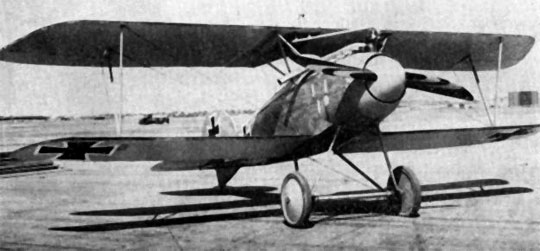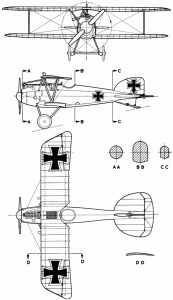
Albatros D.III

Albatros D.III
Length: 7.33 m (24 ft 0 in)
Wingspan: 9.00 m (29 ft 6 in)
Height: 2.90 m (9 ft 6 in)
Wing area: 23.6 m² (254 ft²)
Loaded weight: 886 kg (1,949 lb)
Engine: Mercedes D.IIIa inline water cooled engine, 127 kW (170 hp)
Armament: 2 × 7.92 mm (.312 in) LMG 08/15 machine guns
Maximum speed: 175 km/h (94 kn, 109 mph) at sea level
Range: 480 km (261 nmi, 300 mi)
Service ceiling: 5,500 m (18,044 ft)
Rate of climb: 4.5 m/s (886ft/min)
History
Design started on the Albatros D.III sometime in late July 1916 and it entered operational service in December 1916. It was based on the already successful D.I and D.II models but with a sesquiplane wing arrangement, that is its lower wing was much smaller than its upper. This wing design allowed for greater maneuverability, rate of climb and downward visibility.
The Albatros D.III was not without it faults. It was not until it entered the rigors of operational service that a tendency for cracks to appear in the lower wing became apparent. One German pilot lost his life to wing failure and Manfred von Richthofen was so alarmed by the cracks that appeared in the lower wing of his D.III that he refused to fly one until the issue was addressed. Initally attributed to poor materials and workmanship the problem was eventually traced to a design flaw. The main spar in the lower wing was placed too far back, allowing the wing to flex under the dynamic loads of acrobatics. All D.IIIs were ordered grounded for a three week period at the start of February 1917 until new planes with strengthened lower wings were made available. While the plane thereafter became extremely popular and numerous on the Western front it never really overcame this problem and pilots were cautioned to avoid certain maneuvers.
Despite all this the Albatros D.III was generally considered superior to any Allied fighter at the time it entered service. This discrepancy allowed the Germans air superiority that peaked in the “Bloody April” of 1917. In that month the British lost 245 aircraft to the German’s 66. The D.III’s of Jasta 11 led by Manfred von Richthofen accounted for 89, or over a third, of the British losses. After April newer Allied planes started seeing widespread use and the German advantage was lost.
The number of D.IIIs in service peaked in November 1917 with 446 planes at the front. D.III’s were in active service until the end of the War.
In the Game
Like its real life counter-part, the Albatros D.III in the game of Blue Max is a mixed bag.
It is the only plane available in January 1917 on either side with two machine guns. This effectively makes the full three hex range of the guns usable. The Albatros D.III keeps this advantage until the introduction of the Allies’ S.E.5a in June 1917.
The Albatros D.III has the same spread of maneuvers as its contemporaries the Nieuport 17 and Siemens-Schuckert D.I. Its biggest downside is its terrible fuel consumption. The Albatros uses more fuel per maneuver than its rivals. Given it has the same fuel capacity, the Albatros will be running on vapors and gliding long before a rival.
The Albatros has two strategies available to it then: either stay on the German side of the board, conserving fuel and waiting for the enemy to come to it (which reflects the orders given to German pilots of the time), or aggressively go after the enemy and hope to down them with its twin guns before it runs out of fuel.
What the Albatros must avoid is being caught far from the German side of the board when the fuel runs out. Opponents will be expecting it. Gliding makes it a slow and extremely predictable target. When fuel starts to get low the Albatros should retire from German side of the board or get as close to it as possible.


Leave a Reply